Chapter 22 - Toxic Effects of Pesticides
1/26
Earn XP
Description and Tags
Exam 3
Name | Mastery | Learn | Test | Matching | Spaced |
|---|
No study sessions yet.
27 Terms
Pesticides
Any substance or mixture of substances intended for preventing, destroying, or repelling pests. Pests can be insects, weeds, fungi, microorganisms, rodents, and other unwanted organisms.
Non-target
Fill in the blank…
The use of pesticides must minimize the possibility of exposure of ( ) organisms to harmful quantities of these chemicals.
1) Insecticides
2) Herbicides
3) Fungicides
4) Rodenticides
What are the four main classes of pesticides?
1) Oral
2) Dermal
3) Inhalation
What are the major routes of exposure to pesticides?
High/low
Fill in the blank…
( ) oral doses leading to severe poisoning and death are achieved from suicidal pesticide ingestion or accidental ingestion, usually caused by improper storage of pesticides. Chronic ( ) doses are consumed by the general population due to pesticide residues in food and drinking water.
Insecticides
Chemicals that are mainly used as neurotoxicants to poison the nervous systems of target organisms. They are incredibly non-species selective and have higher acute toxicity than other pesticides, especially those containing organophosphates.
Parathion
An organophosphorus compound that is used as an insecticide. This compound, like other organophosphorus compounds, has a leaving group that is displaced through hydrolysis when the OP phosphorylates acetylcholinesterase.
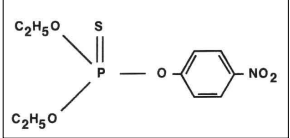
Bioactivation/P-O/desulfurization/oxon
Fill in the blank…
For organophosphate compounds, which contain a sulfur bound to a phosphorus, a metabolic ( ) is necessary since only compounds with a ( ) moiety are effective inhibitors of AChE. The bioactivation consists of an oxidative ( ) catalyzed by cytochrome P450, forming an ( ) of oxygen analog.
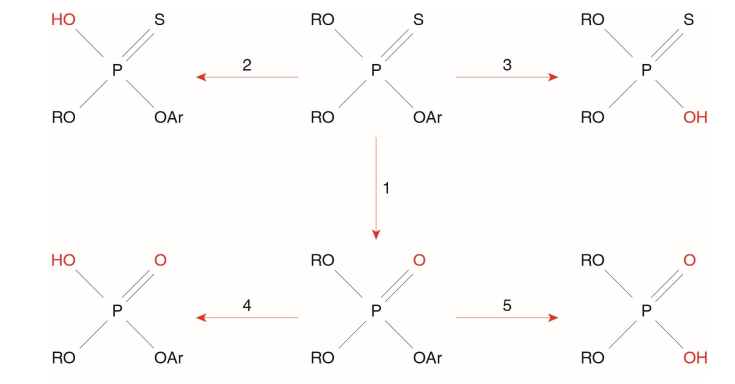
High/acetylcholinesterase/hydrolyze
Fill in the blank…
Organophosphate compounds have ( ) acute toxicity. Their primary target is ( ), a B-esterase whose physiological role is to ( ) acetylcholine.
Atropine
Fill in the blank…
Dermal exposures to organophosphate compounds should be treated by removing contaminated clothing and washing skin with alkaline soap. Ingestion of these compounds should be treated with large doses of ( ), which is a muscarinic receptor antagonist that prevents the action of acetylcholine.
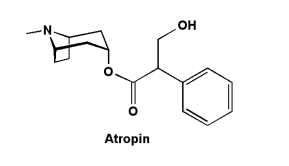
Carbamates
Compounds commonly found in insecticides that are derived from carbamic acid, usually N-methylcarbamates. They present different levels of acute oral toxicity, with carbaryl having the highest and aldicarb having the lowest toxicity. Dermal toxicity is low, but can be amplified by combination with different organic solvents.

Biotransformation/acetylcholinesterase
Fill in the blank…
Carbamates are highly susceptible to a variety of enzyme-catalyzed ( ) reactions, but most metabolites are not biologically active. The mechanism of toxicity of carbamates is analogous to that of OPs; they inhibit ( ). Symptoms of poisoning are similar to OP poisoning and include urination, diarrhea, salivation, muscle contraction, and CNS effects.
Pyrethroids
Insecticides with high insecticidal potency, relatively low mammalian toxicity, lack of environmental persistance, and low tendency to induce insect resistance. Toxicity in mammals due to this compound is caused by disruption of the voltage-gated sodium channels.
They all contain an acid and alcohol moieties linked by an ester bond.
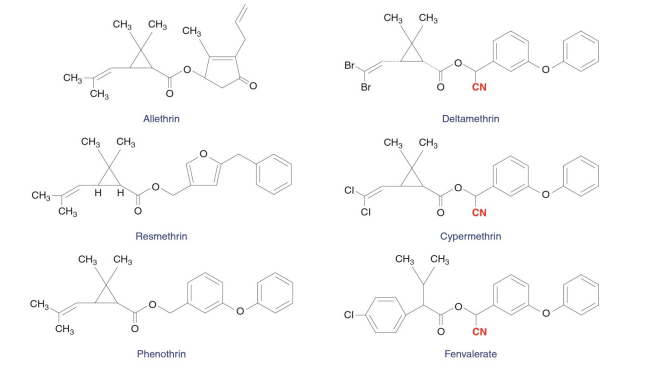
Organochlorine Compounds
Insecticides that include chlorinated ethane derivatives like DDT, cyclodienes, hexachlorocyclohexanes, and caged structures.
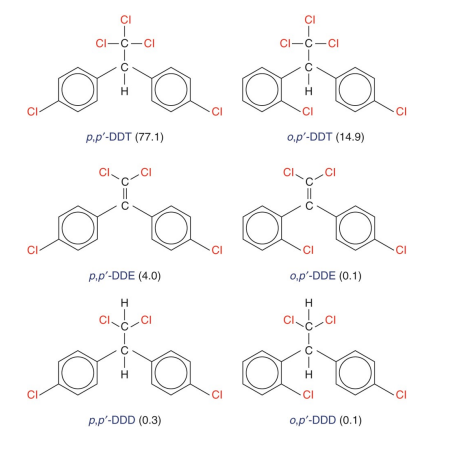
Limited/adipose/slowly
Fill in the blank…
DDT has a moderate acute toxicity. It has ( ) dermal absorption, but its distributes in all tissues with the highest concentrations being found in ( ) tissue. It is also extensively but ( ) metabolized.
Acute/liver
Fill in the blank…
( ) exposure to DDT causes motor unrest, increased frequency of spontaneous movements, abnormal susceptibility to hear and hypersusceptibility to external stimuli. While this exposure is a rare event, chronic exposure is a primary concern and its main target is the ( ).
Sodium/ATPases/lowers
Fill in the blank…
The main effect of DDT is to slow down the closing of ( ) channels once they have opened, while having little or no effect on closed gates. It also affects ( ), especially the calcium version which maintains high external calcium concentrations. Inhibition of this enzyme ( ) external calcium and contributes to membrane instability and repetitive firing.
Hexachlorocyclohexanes and Cyclodienes
Organochlorine insecticides that interfere with gamma-aminobutyric acid (GABA)-mediated neurotransmission. Blockage of these channels reduces neuronal inhibition, leading to hyper-excitation of the CNS, convulsions, and death. They are readily absorbed by the skin.
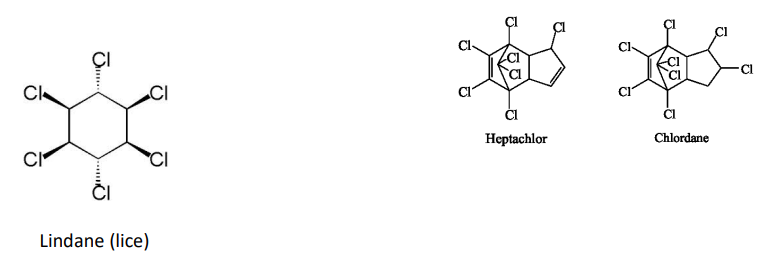
Herbicides
Chemicals that are capable of either killing or severely injuring plants. Compared to other pesticides, these have very low acute toxicity, though paraquat is an exception. They mainly cause dermal irritation and contact dermatitis, especially in people prone to allergic reactions.
Chlorophenoxy
A compound in herbicides that are characterized by an aliphatic carboxylic acid moiety attached to a chlorine or methyl-substituted aromatic ring. Ingestion of these compounds, such as 2,4-dichlorophenoxyacetic acid (2,4-D), causes acute poisoning in humans that can be treated with intravenous administration of bicarbonate.
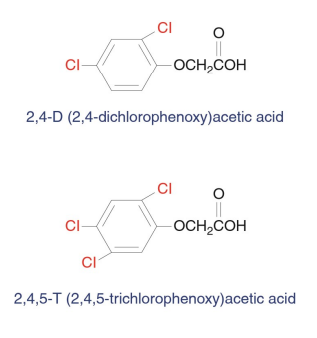
Agent Orange
A 50:50 mixture of n-butyl esters 2,4-D and 2,4,5-trichlorophenol used extensively as a defoliant in the Vietnam war.
Paraquat
A bipyridyl compound that comprises a class of herbicides. It has one of the highest acute toxicities and is most toxic when administered intravenously, indicating it has poor gastrointestinal absorption. It is also poorly absorbed through the skin. It accumulates in the lung and kidney, is poorly metabolized, and excreted unchanged in urine.
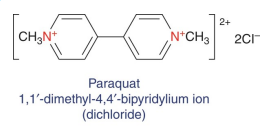
Radical/redox cycling/lipid peroxidation/NADPH
Fill in the blank…
Once paraquat enters a cell, it undergoes alternate reduction to form a free ( ) followed by reoxidation with a concomitant production of superoxide anion, a process known as ( ). This generation of superoxide anion and hydroxy radicals initiates ( ), leading to cell death. It also causes oxidation of ( ), which leads to its cellular depletion.
Fluoroacetate
A component of rodenticides that is incorporated into coenzyme A to form fluoracetyl-CoA, which condenses with oxaloacetate to form fluorocitrate and inhibits mitochondrial aconitase. This inhibits the citric acid cycle, leading to lowered energy production, reduced oxygen consumption, and reduced ATP concentration. This mainly contributes to its toxicity, but can also be caused by accumulation of citrate, which is a potent chelator of calcium.
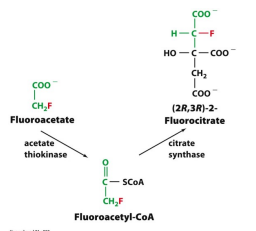
Gastrointestinal symptoms, followed by cardiovascular effects (ventricular tachycardia, hypotension, etc) and CNS effects (agitation, convulsions, and coma)
What are the symptoms of fluoroacetate poisoning?
Fungicides
Pesticides derived from a variety of substances, from simple inorganic compounds like copper sulfate to complex organic compounds. They have very low acute toxicity in mammals, though some have tested positive for genotoxicity and carcinogenic potential.
Diseases caused by fungi are nearly impossible to control without these compounds.
Rodenticides
The ultimate goal of these compounds is high species selectivity. Advantage is often taken of the physiology and biochemistry unique to the organisms targeted by these compounds.
Criteria for successful compounds include
1) Effective in target species once incorporated into bait
2) Baits containing the poison shouldn’t induce bait shyness
3) The manner of death should not induce suspicion in other members of the species
4) It needs to be species specific and should not target other animals.